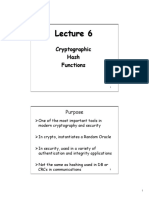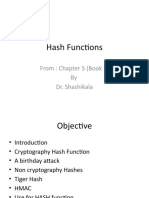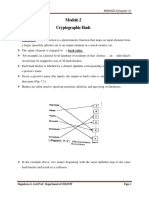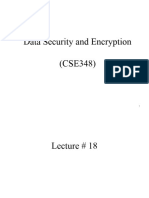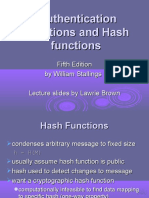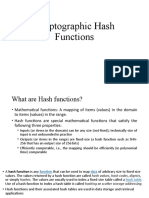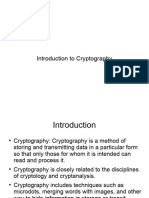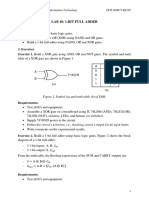Chapter 5: Hash
Functions++
“I'm sure [my memory] only works one way.” Alice remarked.
“I can't remember things before they happen.”
“It's a poor sort of memory that only works backwards,”
the Queen remarked.
“What sort of things do you remember best?" Alice ventured to ask.
“Oh, things that happened the week after next,"
the Queen replied in a careless tone.
Lewis Carroll, Through the Looking Glass
Part 1 Cryptography
1
Confidentiality
in the Real World
Part 1 Cryptography
2
Symmetric Key vs Public
Key
Symmetric key +’s
o Speed
o No public key infrastructure (PKI)
needed (but have to
generate/distribute keys)
Public Key +’s
o Signatures (non-repudiation)
o No shared secret (but, do have to get
private keys to the right user…)
Part 1 Cryptography
3
Notation Reminder
Public key notation
o Sign M with Alice’s private key
[M]Alice
o Encrypt M with Alice’s public key
{M}Alice
Symmetric key notation
o Encrypt P with symmetric key K
C = E(P,K)
o Decrypt C with symmetric key K
P = D(C,K)
Part 1 Cryptography
4
Real World Confidentiality
Hybrid cryptosystem
o Public key crypto to establish a key
o Symmetric key crypto to encrypt data…
I’m Alice, {K}Bob
E(Bob’s data, K)
E(Alice’s data, K)
Alice Bob
Can Bob be sure he’s talking to Alice?
Part 1 Cryptography
5
Chapter 5: Hash
Functions++
A boat, beneath a sunny sky
Lingering onward dreamily
In an evening of July
Children three that nestle near,
Eager eye and willing ear,
...
Lewis Carroll, Through the Looking Glass
Part 1 Cryptography
6
Hash Function Motivation
Suppose Alice signs M
o Alice sends M and S = [M]Alice to Bob
o Bob verifies that M = {S}Alice
o Can Alice just send S?
If M is big, [M]Alice costly to compute &
send
Suppose instead, Alice signs h(M), where
h(M) is a much smaller “fingerprint” of M
o Alice sends M and S = [h(M)]Alice to Bob
o Bob verifies that h(M) = {S}Alice
Part 1 Cryptography
7
Hash Function Motivation
So, Alice signs h(M)
o That is, Alice computes S = [h(M)]Alice
o Alice then sends (M, S) to Bob
o Bob verifies that h(M) = {S}Alice
What properties must h(M) satisfy?
o Suppose Trudy finds M’ so that h(M) = h(M’)
o Then Trudy can replace (M, S) with (M’, S)
Does Bob detect this tampering?
o No, since h(M’) = h(M) = {S}Alice
Part 1 Cryptography
8
Crypto Hash Function
Crypto hash function h(x) must provide
o Compression output length is small
o Efficiency h(x) easy to compute for any x
o One-way given a value y it is infeasible to
find an x such that h(x) = y
o Weak collision resistance given x and
h(x), infeasible to find y x such that h(y) =
h(x)
o Strong collision resistance infeasible to
find any x and y, with x y such that h(x) =
h(y)
PartLots
of collisions
1 Cryptography exist, but hard to find
9
Crypto Hash Function
If h(x) is N bits, then 2N different hash
values are possible
So, if you hash about sqrt(2N) = 2N/2
values then you expect to find a
collision
Implication? “Exhaustive search”
attack…
o Secure N-bit hash requires 2N/2 work to
“break”
o Recall that secure N-bit symmetric cipher
has work factor of 2N1
Part 1 Cryptography
13
Non-crypto Hash (1)
Data X = (X1,X2,X3,…,Xn), each Xi is a byte
Define h(X) = (X1+X2+X3+…+Xn) mod 256
Is this a secure cryptographic hash?
Example: X = (10101010, 00001111)
Hash is h(X) = 10111001
If Y = (00001111, 10101010) then h(X) =
h(Y)
Easy to find collisions, so not secure…
Part 1 Cryptography
14
Non-crypto Hash (2)
Data X = (X0,X1,X2,…,Xn-1)
Suppose hash is defined as
h(X) = (nX1+(n1)X2+(n2)X3+…+2Xn-1+Xn)
mod 256
Is this a secure cryptographic hash?
Note that
h(10101010, 00001111) h(00001111,
10101010)
But hash of (00000001, 00001111) is
same as hash of (00000000, 00010001)
Not “secure”, but this hash is used in
Part 1 Cryptography
15 the (non-crypto) application rsync
Non-crypto Hash (3)
Cyclic Redundancy Check (CRC)
Essentially, CRC is the remainder in a
long division calculation
Good for detecting burst errors
o Such random errors unlikely to yield a
collision
But easy to construct collisions
o In crypto, Trudy is the enemy, not “random”
CRC has been mistakenly used where
crypto integrity check is required (e.g.,
WEP)
Part 1 Cryptography
16
Popular Crypto Hashes
MD5 invented by Rivest (of course…)
o 128 bit output
o MD5 collisions easy to find, so it’s broken
SHA family A U.S. government
standard, inner workings similar to MD5
o SHA-1 160 bit output
Hashes work by hashing message in
blocks
Part 1 Cryptography
17
Crypto Hash Design
Desired property: avalanche effect
o Change to 1 bit of input should affect about
half of output bits
Crypto hash functions consist of some
number of rounds
Want security and speed
o “Avalanche effect” after few rounds
o But simple rounds
Analogous to design of block ciphers
Part 1 Cryptography
18
Cryptographic hash
functions
When security people talk about hash
functions, they mean cryptographic (or secure)
hash functions
These should provide
o Collision resistance
Difficult to find any M, M’≠ M s.t. h(M) = h(M’)
o Preimage resistance
Given h(M), difficult to find M’ s.t. h(M’)=h(M)
o Second preimage resistance
Given M, difficult to find M’ s.t. h(M’)=h(M), M’≠M
If a hash function h does not meet these
IL!
requirements… FA
But what does it all mean?
If h is secure
o Easy to compute in one direction
o Very difficult to compute in the other
direction
Computationally infeasible
i.e. your grandchildren’s grandchildren’s
grandchildren will be long gone before
that computation finishes
o Very difficult to find two messages
that hash to the same value
MD5
MD5
MD5 algorithm was developed by Professor
Ronald L. Rivest in 1991. According to RFC
1321, “MD5 message-digest algorithm takes
as input a message of arbitrary length and
produces as output a 128-bit "fingerprint" or
"message digest" of the input …The MD5
algorithm is intended for digital signature
applications, where a large file must be
"compressed" in a secure manner before being
encrypted with a private (secret) key under a
public-key cryptosystem such as RSA.”
MD5 Algorithm Structure
Implementation Steps
Step1 Append padding bits
The input message is "padded" (extended) so
that its length (in bits) equals to 448 mod 512.
Padding is always performed, even if the
length of the message is already 448 mod 512.
Padding is performed as follows: a single "1"
bit is appended to the message, and then "0"
bits are appended so that the length in bits of
the padded message becomes congruent to
448 mod 512. At least one bit and at most 512
bits are appended.
Implementation Steps
Step2. Append length
A 64-bit representation of the length of the
message is appended to the result of step1. If
the length of the message is greater than
2^64, only the low-order 64 bits will be used.
The resulting message (after padding with bits
and with b) has a length that is an exact
multiple of 512 bits. The input message will
have a length that is an exact multiple of 16
(32-bit) words.
Implementation Steps
Step3. Initialize MD buffer
A four-word buffer (A, B, C, D) is used to compute
the message digest. Each of A, B, C, D is a 32-bit
register. These registers are initialized to the
following values in hexadecimal, low-order bytes
first):
word A: 01 23 45 67
word B: 89 ab cd ef
word C: fe dc ba 98
word D: 76 54 32 10
Implementation Steps
Step4. Process message in 16-word blocks
Four functions will be defined such that each
function takes an input of three 32-bit words
and produces a 32-bit word output.
F (X, Y, Z) = XY or not (X) Z
G (X, Y, Z) = XZ or Y not (Z)
H (X, Y, Z) = X xor Y xor Z
I (X, Y, Z) = Y xor (X or not (Z))
Implementation Steps
Round 1.
[abcd k s i] denote the operation a = b + ((a + F
(b, c, d) + X [k] + T [i]) <<< s).
Do the following 16 operations.
[ABCD 0 7 1] [DABC 1 12 2] [CDAB 2 17 3]
[BCDA 3 22 4]
[ABCD 4 7 5] [DABC 5 12 6] [CDAB 6 17 7]
[BCDA 7 22 8]
[ABCD 8 7 9] [DABC 9 12 10] [CDAB 10 17 11]
[BCDA 11 22 12]
[ABCD 12 7 13] [DABC 13 12 14] [CDAB 14 17 15]
[BCDA 15 22 16]
Performance
Key size/hash Extrapolated PRB
size(bits) Speed Optimized
(Kbytes/sec.) (Kbytes/sec.)
TEA 128 700 -
DES 56 350 7746
Triple-DES 112 120 2842
IDEA 128 700 4469
RSA 512 7 -
SHA 160 750 25162
MD5 128 1740 62425
Secure Hash Algorithm
(SHA)
Who can compute a hash?
A hash is a keyless algorithm
Anyone can compute h(x) if they
know x
Eve could replace M with M’ and
h(M) with h(M’)
o The hash matches what Bob computes,
so he assumes that Alice sent him M’
How could we stop Eve from doing
HMAC
(Hash-based Message
Authentication Code)
HMAC
Can compute a MAC of the message M with
key K using a “hashed MAC” or HMAC
Provides some level of authentication
o If only and Alice and Bob know the key and the HMAC
is correct, it must have come from one of them
HMAC is a keyed hash
o Why would we need a key?
How to compute HMAC?
Two obvious choices: h(K,M) and h(M,K)
Which is better?
Part 1 Cryptography
47
HMAC
Should we compute HMAC as h(K,M) ?
Hashes computed in blocks
o h(B ,B ) = F(F(A,B ),B ) for some F and
1 2 1 2
constant A
o Then h(B ,B ) = F(h(B ),B )
1 2 1 2
Let M’ = (M,X)
o Then h(K,M’) = F(h(K,M),X)
o Attacker can compute HMAC of M’ without K
Is h(M,K) better?
o Yes, but… if h(M’) = h(M) then we might have
h(M,K)=F(h(M),K)=F(h(M’),K)=h(M’,K)
Part 1 Cryptography
48
Correct Way to HMAC
Described in RFC 2104
Let B be the block length of hash, in
bytes
o B = 64 for MD5 and SHA-1 and Tiger
ipad = 0x36 repeated B times
opad = 0x5C repeated B times
Then
HMAC(M,K) = h(K opad, h(K ipad, M))
Part 1 Cryptography
49
Hash Uses
Authentication (HMAC)
Message integrity (HMAC)
Message fingerprint
Data corruption detection
Digital signature efficiency
Anything you can do with symmetric
crypto
Also, many, many clever/surprising
Partuses…
1 Cryptography
50
Reading part
Tiger Hash
“Fastand strong”
Designed by Ross Anderson and Eli
Biham leading cryptographers
Design criteria
o Secure
o Optimized for 64-bit processors
o Easy replacement for MD5 or SHA-1
Part 1 Cryptography
60
Tiger Hash
Like MD5/SHA-1, input divided into 512
bit blocks (padded)
Unlike MD5/SHA-1, output is 192 bits
(three 64-bit words)
o Truncate output if replacing MD5 or SHA-1
Intermediate rounds are all 192 bits
4 S-boxes, each maps 8 bits to 64 bits
A “key schedule” is used
Part 1 Cryptography
61
a b c
Xi
Tiger Outer
Round
F5 W Input is X
key schedule o X = (X0,X1,…,Xn-1)
o X is padded
F7 W
o Each Xi is 512 bits
key schedule
There are n iterations
F9 W of diagram at left
o One for each input
block
a b c
Initial (a,b,c)
a b c constants
Final (a,b,c) is hash
Part 1 Cryptography
62 Looks like block
Tiger Inner
Rounds a b c
Each Fm consists of
fm,0 w0
precisely 8 rounds
512 bit input W to fm.1 w1
Fm
fm,2 w2
o W=(w0,w1,…,w7)
o W is one of the input
blocks Xi
All lines are 64 bits fm,7 w7
The fm,i depend on
a b c
the S-boxes (next
Part 1 Cryptography
63
slide)
Tiger Hash: One Round
Each fm,i is a function of a,b,c,wi and m
o Input values of a,b,c from previous round
o And wi is 64-bit block of 512 bit W
o Subscript m is multiplier
o And c = (c0,c1,…,c7)
Output of fm,i is
o c = c wi
o a = a (S0[c0] S1[c2] S2[c4] S3[c6])
o b = b + (S3[c1] S2[c3] S1[c5] S0[c7])
ob=bm
Each Si is S-box: 8 bits mapped to 64
bits
Part 1 Cryptography
64
Tiger Hash
Key x0 = x0 (x7
0xA5A5A5A5A5A5A5A5)
Schedule x1 = x 1 x0
x2 = x 2 x1
Input is X x3 = x3 (x2 ((~x1) << 19))
o X=(x0,x1, x4 = x 4 x3
…,x7) x5 = x5 +x4
x6 = x6 (x5 ((~x4) >> 23))
Smallchange x7 = x 7 x6
in X will x0 = x0 +x7
produce large x1 = x1 (x0 ((~x7) << 19))
x2 = x 2 x1
change in key x3 = x3 +x2
schedule x4 = x4 (x3 ((~x2) >> 23))
output x5 = x 5 x4
Part 1 Cryptography x6 = x6 +x5
65 x7 = x7 (x6
Tiger Hash Summary (1)
Hash and intermediate values are 192
bits
24 (inner) rounds
o S-boxes: Claimed that each input bit affects
a, b and c after 3 rounds
o Key schedule: Small change in message
affects many bits of intermediate hash values
o Multiply: Designed to ensure that input to S-
box in one round mixed into many S-boxes in
next
S-boxes, key schedule and multiply
Parttogether
1 Cryptographydesigned to ensure strong
66
avalanche effect
Tiger Hash Summary (2)
Uses lots of ideas from block
ciphers
o S-boxes
o Multiple rounds
o Mixed mode arithmetic
At a higher level, Tiger employs
o Confusion
o Diffusion
Part 1 Cryptography
67
Online Bids
Suppose Alice, Bob and Charlie are
bidders
Alice plans to bid A, Bob B and Charlie C
They don’t trust that bids will stay secret
A possible solution?
o Alice, Bob, Charlie submit hashes h(A), h(B),
h(C)
o All hashes received and posted online
o Then bids A, B, and C submitted and
revealed
Hashes don’t reveal bids (one way)
Can’t change bid after hash sent
68 (collision)
Part 1 Cryptography
Hashing for Spam
Reduction
Spam reduction
Before accept email, want proof
that sender had to “work” to
create email
o Here, “work” == CPU cycles
Goal is to limit the amount of email
that can be sent
o This approach will not eliminate spam
o Instead, make spam more costly to
Part 1 Cryptography
69 send
Spam Reduction
Let M = complete email message
R = value to be determined
T = current time
Sender must determine R so that
h(M,R,T) = (00…0,X), that is,
initial N bits of hash value are all zero
Sender then sends (M,R,T)
Recipient accepts email, provided
that…
h(M,R,T) begins with N zeros
Part 1 Cryptography
70
Spam Reduction
Sender: h(M,R,T) begins with N zeros
Recipient: verify that h(M,R,T) begins
with N zeros
Work for sender: on average 2N
hashes
Work for recipient: always 1 hash
Sender’s work increases exponentially
in N
Small work for recipient, regardless of N
Choose N so that…
o Work acceptable for normal amounts of
email
Part 1 Cryptography
71
o
Secret Sharing
Part 1 Cryptography
72
Shamir’s Secret Sharing
Y Two points determine a
line
Give (X ,Y ) to Alice
(X1,Y1) (X0,Y0) 0 0
Give (X1,Y1) to Bob
(0,S) Then Alice and Bob must
cooperate to find secret S
X Also works in discrete
2 out of 2 case
Easy to make “m out of n”
Part 1 Cryptography
73 scheme for any m n
Shamir’s Secret Sharing
Y Give (X0,Y0) to Alice
(X0,Y0) Give (X1,Y1) to Bob
(X1,Y1) Give (X2,Y2) to Charlie
(X2,Y2)
Then any two can
(0,S) cooperate to find secret S
No one can determine S
X
A “2 out of 3” scheme
2 out of 3
Part 1 Cryptography
74
Shamir’s Secret Sharing
Y Give (X0,Y0) to Alice
(X0,Y0) Give (X1,Y1) to Bob
(X1,Y1)
Give (X2,Y2) to Charlie
(X2,Y2)
3 pts determine
(0,S)
parabola
Alice, Bob, and Charlie
X
3 out of 3 must cooperate to find S
A “3 out of 3” scheme
Part 1 Cryptography
75
What about “3 out of
Secret Sharing Use?
Key escrow suppose it’s required
that your key be stored somewhere
Key can be “recovered” with court order
But you don’t trust FBI to store your
keys
We can use secret sharing
o Say, three different government agencies
o Two must cooperate to recover the key
Part 1 Cryptography
76
Secret Sharing Example
Y Your symmetric key is
(X0,Y0) K
Point (X0,Y0) to FBI
(X1,Y1)
(X2,Y2) Point (X1,Y1) to DoJ
(0,K) Point (X2,Y2) to DoC
To recover your key K,
X
two of the three
agencies must
cooperate
Part 1 Cryptography
77 No one agency can get
Visual Cryptography
Another form of secret sharing…
Alice and Bob “share” an image
Both must cooperate to reveal the
image
Nobody can learn anything about image
from Alice’s share or Bob’s share
o That is, both shares are required
Is this possible?
Part 1 Cryptography
78
Visual Cryptography
How to “share” a pixel?
Suppose image is black and white
Then each
pixel is either
black or white
We split pixels
as shown
Part 1 Cryptography
79
Sharing Black & White
Image
If pixel is white, randomly choose
a or b for Alice’s/Bob’s shares
If pixel is
black,
randomly
choose c or d
No
information
in one “share”
Part 1 Cryptography
80
Visual Crypto Example
Alice’s Bob’s Overlai
share share d
shares
Part 1 Cryptography
81
Visual Crypto
How does visual “crypto” compare
to regular crypto?
In visual crypto, no key…
o Or, maybe both images are the key?
With encryption, exhaustive search
o Except for the one-time pad
Exhaustive search on visual crypto?
o No exhaustive search is possible!
Part 1 Cryptography
82
Visual Crypto
Visual crypto no exhaustive search…
How does visual crypto compare to
crypto?
o Visual crypto is “information theoretically”
secure also true of secret sharing
schemes
o With regular encryption, goal is to make
cryptanalysis computationally infeasible
Visual crypto an example of secret
sharing
o Not really a form of crypto, in the usual
sense
Part 1 Cryptography
83
Random Numbers in
Cryptography
Part 1 Cryptography
84
Random Numbers
Random numbers used to generate keys
o Symmetric keys
o RSA: Prime numbers
o Diffie Hellman: secret values
Random numbers used for nonces
o Sometimes a sequence is OK
o But sometimes nonces must be random
Random numbers also used in
simulations, statistics, etc.
o In such apps, need “statistically” random
numbers
Part 1 Cryptography
85
Random Numbers
Cryptographic random numbers must
be statistically random and
unpredictable
Suppose server generates symmetric
keys
o Alice: K
A
o Bob: K
B
o Charlie: K
C
o Dave: K
D
Alice, Bob, and Charlie don’t like Dave…
PartAlice, Bob, and Charlie, working
1 Cryptography
86
together, must not be able to determine
Non-random Random
Numbers
Online version of Texas Hold ‘em Poker
o ASF Software, Inc.
Random numbers used to shuffle the
deck
Program did not produce a random
shuffle
Part 1 Cryptography
87 A serious problem, or not?
Card Shuffle
There are 52! > 2225 possible shuffles
The poker program used “random” 32-
bit integer to determine the shuffle
o So, only 232 distinct shuffles could occur
Code used Pascal pseudo-random
number generator (PRNG):
Randomize()
Seed value for PRNG was function of
number of milliseconds since midnight
Less than 227 milliseconds in a day
o So, less than 227 possible shuffles
Part 1 Cryptography
88
Card Shuffle
Seed based on milliseconds since
midnight
PRNG re-seeded with each shuffle
By synchronizing clock with server,
number of shuffles that need to be
tested 218
Could then test all 218 in real time
o Test each possible shuffle against “up”
cards
Attacker knows every card after the
first of five rounds of betting!
Part 1 Cryptography
89
Poker Example
Poker program is an extreme example
o But common PRNGs are predictable
o Only a question of how many outputs must
be observed before determining the
sequence
Crypto random sequences not
predictable
o For example, keystream from RC4 cipher
o But “seed” (or key) selection is still an issue!
How to generate initial random values?
o Keys (and, in some cases, seed values)
Part 1 Cryptography
90
What is Random?
True“random” is hard to define
Entropy is a measure of
randomness
Good sources of “true” randomness
o Radioactive decay but, radioactive
computers are not too popular
o Hardware devices many good ones
on the market
o Lava lamp relies on chaotic
Part 1 behavior
Cryptography
91
Randomness
Sources of randomness via software
o Software is supposed to be deterministic
o So, must rely on external “random” events
o Mouse movements, keyboard dynamics,
network activity, etc., etc.
Can get quality random bits by such
methods
But quantity of bits is very limited
Bottom line: “The use of pseudo-random
processes to generate secret quantities
can result in pseudo-security”
Part 1 Cryptography
92
Information Hiding
Part 1 Cryptography
93
Information Hiding
Digital Watermarks
o Example: Add “invisible” info to data
o Defense against music/software
piracy
Steganography
o “Secret” communication channel
o Similar to a covert channel (more
later)
o Example: Hide data in an image file
Part 1 Cryptography
94
Watermark
Add a “mark” to data
Visibility (or not) of watermarks
o Invisible Watermark is not obvious
o Visible Such as TOP SECRET
Strength (or not) of watermarks
o Robust Readable even if attacked
o Fragile Damaged if attacked
Part 1 Cryptography
95
Watermark Examples
Add robust invisible mark to digital
music
o If pirated music appears on Internet, can
trace it back to original source of the leak
Add fragile invisible mark to audio file
o If watermark is unreadable, recipient knows
that audio has been tampered with
(integrity)
Combinations of several types are
sometimes used
o E.g., visible plus robust invisible watermarks
Part 1 Cryptography
96
Watermark Example (1)
Non-digital watermark: U.S.
currency
Image embedded in paper on rhs
o Hold bill to light to see embedded info
Part 1 Cryptography
97
Watermark Example (2)
Add invisible watermark to photo
Claim is that 1 inch2 contains
enough info to reconstruct entire
photo
If photo is damaged, watermark
can be used to reconstruct it!
Part 1 Cryptography
98
Steganography
According to Herodotus (Greece 440 BC)
o Shaved slave’s head
o Wrote message on head
o Let hair grow back
o Send slave to deliver message
o Shave slave’s head to expose a message
warning of Persian invasion
Historically, steganography used by
military more often than cryptography
Part 1 Cryptography
99
Images and
Steganography
Images use 24 bits for color: RGB
o 8 bits for red, 8 for green, 8 for blue
For example
o 0x7E 0x52 0x90 is this color
o 0xFE 0x52 0x90 is this color
While
o 0xAB 0x33 0xF0 is this color
o 0xAB 0x33 0xF1 is this color
Low-order bits don’t matter…
Part 1 Cryptography
100
Images and Stego
Given an uncompressed image file…
o For example, BMP format
…we can insert information into low-
order RGB bits
Since low-order RGB bits don’t matter,
changes will be “invisible” to human eye
o But, computer program can “see” the bits
Part 1 Cryptography
101
Stego Example 1
Left side: plain Alice image
Right side: Alice with entire Alice in
Wonderland (pdf) “hidden” in the image
Part 1 Cryptography
102
Non-Stego Example
Walrus.html in web browser
“View source” reveals:
<font color=#000000>"The time has come," the Walrus
said,</font><br>
<font color=#000000>"To talk of many things: </font><br>
<font color=#000000>Of shoes and ships and sealing wax
</font><br>
<font color=#000000>Of cabbages and kings </font><br>
<font color=#000000>And why the sea is boiling hot
</font><br>
Part 1 Cryptography
<font
103 color=#000000>And whether pigs have wings."
</font><br>
Stego Example 2
stegoWalrus.html in web browser
“View source” reveals:
<font color=#000101>"The time has come," the Walrus
said,</font><br>
<font color=#000100>"To talk of many things: </font><br>
<font color=#010000>Of shoes and ships and sealing wax
</font><br>
<font color=#010000>Of cabbages and kings </font><br>
<font color=#000000>And why the sea is boiling hot
“Hidden”
</font><br> message: 011 010 100 100 000
<font color=#010001>And whether pigs have wings."
Part101
</font><br>
1 Cryptography
104
Steganography
Some formats (e.g., image files) are
more difficult than html for humans to
read
o But easy for computer programs to read…
Easy to hide info in unimportant bits
Easy to damage info in unimportant bits
To be robust, must use important bits
o But stored info must not damage data
o Collusion attacks are also a concern
Robust steganography is tricky!
Part 1 Cryptography
105
Information Hiding:
The Bottom Line
Not-so-easy to hide digital information
o “Obvious” approach is not robust
o Stirmark: tool to make most watermarks in
images unreadable without damaging the
image
o Stego/watermarking are active research
topics
If information hiding is suspected
o Attacker may be able to make
information/watermark unreadable
o Attacker may be able to read the
information, given the original document
Part 1 Cryptography
106

